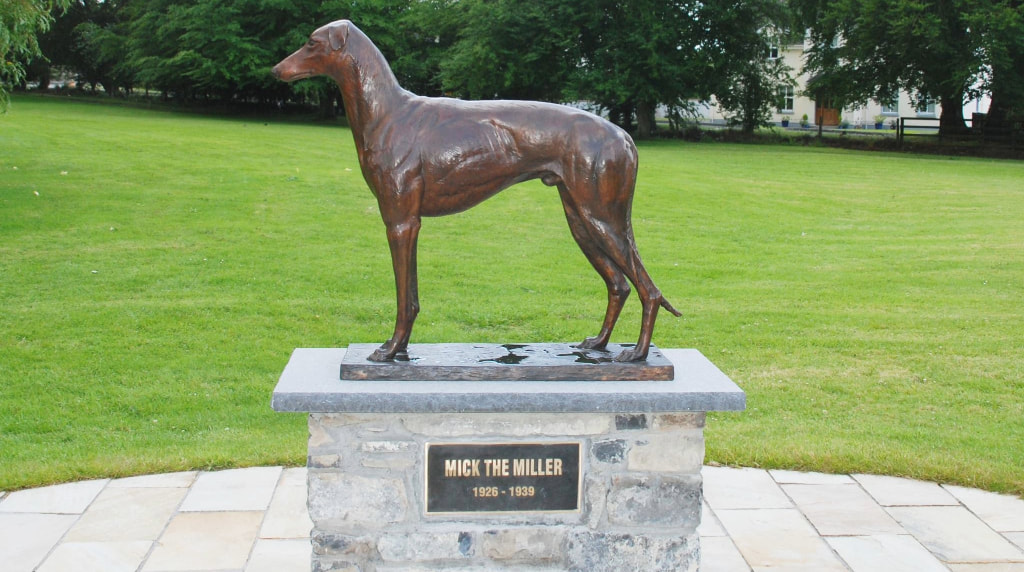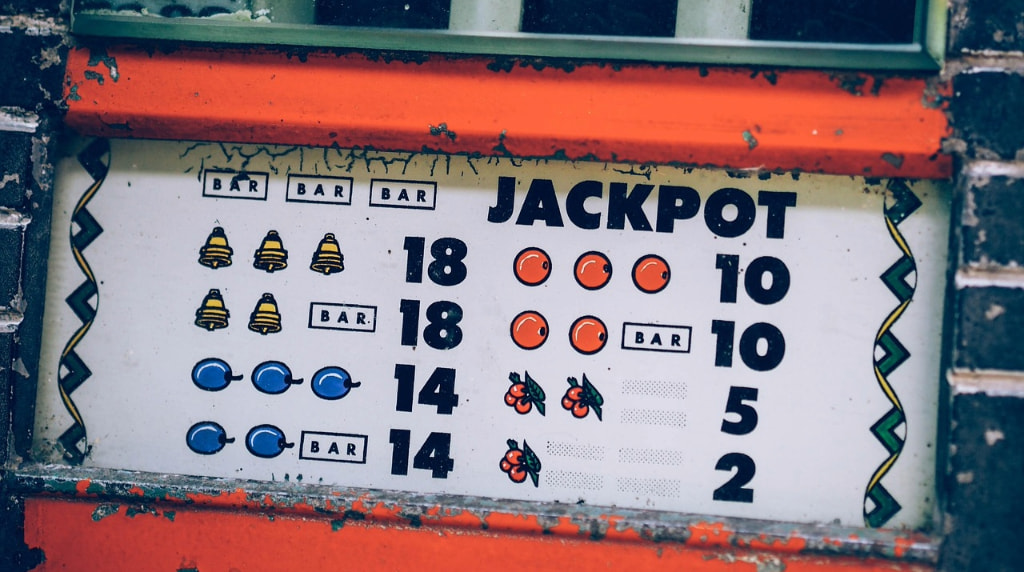Greyhound Racing’s Legendary Trio of Champions
Greyhound racing may lack the widespread appeal it once enjoyed, but legends never die in any sport. Here, we will look at the careers of three remarkable legends – the likes of which we will probably never see again.

Mick The Miller’s bronze statue at his birthplace, Killeigh, County Offaly, Ireland © MickTheMiller Commemoration Committee
Greyhounds Racing’s Undisputable All-Time Great Trio
Like most sports, greyhound racing has had its share of outstanding champions, superstars of their time, adored by the thousands of devoted fans who flocked to see living legends in action. However, comparing athletes of any kind from different generations is rarely easy.
Identifying ‘the greatest’ in sport is impossible by any metric. Amongst truly worthy candidates, opinions will differ wildly from one person to another. However, greyhound racing is different. It is safe to say that the same three greyhounds will appear in most greyhound enthusiasts’ top-five list.
Who are these three legendary greyhounds? Here, you can read the backstory of an immortal trio that utilised very different running styles to win the hearts of devotees and earned national recognition in the mainstream media.
Champion Greyhound, Star of Track and Screen, an Icon
The story of Mick The Miller (1926-1939) is part of greyhound racing folklore. The brindled greyhound was named after Mick Miller, the odd job man at the vicarage where he was born and raised in Killeigh, County Offaly, Ireland.
Few could have predicted he would become a household name, not just in the UK and Ireland but around the world. At a time when many were suffering the effects of the Great Depression, Mick was a genuine sporting hero and an icon of the day. He was as popular as the equine star, Phar Lap, racing on the other side of the world.
Mick The Miller was one of a litter of 10 pups and was considered fortunate to ever make the racetrack. As a youngster, he had been struck down by distemper – a highly contagious and often fatal viral disease that primarily affects dogs.
His owner and breeder, Father Brophy, employed the expertise of Arthur ‘Doc’ Callanan, a veterinary surgeon and manager of Shelbourne Park, a new greyhound track in Dublin. Mick The Miller survived, and when fully recovered, he repaid Callanan by winning at the Irish capital’s burgeoning track on his April 18, 1928, racing debut.
Mick quickly built a considerable reputation in the Irish capital by winning 15 of his 20 races at Shelbourne. Trainer Mick Horan advised Father Brophy that the rising star was good enough to win the 1929 Greyhound Derby at the famous White City Stadium in Shepards Bush, London.
Mick Brings Down the House
Connections brought Mick The Miller to England in May 1929, and after a sensational first outing at the track, he was sold to London bookmaker Albert Williams for £800. The sum would have bought a desirable house in the area at the time.
The sale of Mick The Miller was of such significance it was well documented in that day’s evening papers. Subsequently smashing through the then unachievable 30-second barrier for the 525-yard trip, Mick’s path to international fame was underway.
To the dismay of his growing fan club, Mick was beaten into second in the 1929 Derby final, but the initial decider was declared void, and Mick The Miller duly won the re-run. From then on, the clamour to see Mick The Miller race drew crowds comparable to modern-day Premier League matches.
Following his Derby victory, Mick was sold again. His new owner was Phiddy Hugh Kempton. Her husband, Arundel Hugh Kempton, paid £2,000 for the Derby hero as a gift for his wife, and Mick was sent to a new trainer, Sydney Orton, for his 1930 campaign.
Owner Phiddy Kempton says farewell to Mick The Miller, the world's most famous greyhound, who is heading off to stud (December 1931). pic.twitter.com/uUk9zMb4GD
— Sports & Betting History by BestBettingSites (@CDCHistory) March 9, 2024
19 Straight and a Second Derby
After a few defeats early in the year – finishing runner-up in the Champion Stakes at Wimbledon but winning the Spring Cup at Wembley – Mick scored 19 consecutive victories. The streak encompassed a second Derby victory in front of 50,000 spectators, including King Alfonso XIII of Spain.
The ‘people’s champion’ tore a shoulder muscle when bidding for win number 20. During his winning streak, Mick The Miller had broken world records on four occasions, and his exploits saw the sport’s popularity grow enormously.
Mick returned to action in March 1931 and soon returned to his brilliant best, landing the Spring Cup in record time. The pièce de resistance would be a third Derby victory, and despite being well into veteran status, he not only made the final, but he crossed the line ahead in the final.
However, the race – this time attracting 70,000 racegoers – was voided after one runner caused intentional interference. It was re-run an hour later when Mick, the even-money favourite, did not have the legs for his younger rivals and finished fourth.
Gold in the Leger Before Silver Screen
Mick was never quite the same afterwards, but he had one last hurrah in the stayers classic, the 700-yard St Leger at Wembley in September 1931. Remarkably, the brindled greyhound went through the event unbeaten and was retired shortly after that classic contest.
Winning 51 of his 68 races and breaking several track records, a very lucrative career at Stud followed. Mick The Miller also starred in the 1934 film Wild Boy alongside the famous double act of Flanagan and Allen.
After his death, Mick The Miller returned to White City one more time – to watch a Greyhound Derby final. pic.twitter.com/0jT5KsnNxH
— Sports & Betting History by BestBettingSites (@CDCHistory) March 17, 2024
After his death in May 1939, Mick The Miller was stuffed and given to the Natural History Museum in London, where he proudly stood until being moved to the Natural History Museum at Tring in Hertfordshire. Mick The Miller’s legend will continue to stand the test of time.
Bob The Perfect Racing Machine
No top-five greyhound list could exclude the remarkable Ballyregan Bob (1983-1994). The George Curtis-trained dog was a champion in every sense, and he helped put greyhound racing back on the map when it was going through troubled times.
‘Bob’ is famous for setting a world record of 32 consecutive race wins, with his winning streak beginning on May 9, 1985, at Hove and finishing at the same venue on December 9, 1986. All but three of his victories came over the 6-bend stayer trip. His journey to the record was astonishing.
Greyhound sports betting sites sent Ballyregan Bob off as an odds-on favourite in every race during those 19 months when he set, or equalled track records a remarkable 14 times. He would often win by more than 10 lengths.
Ballyregan Bob’s winning run almost ended in August 1985 when he encountered early trouble in the semi-finals of the St Leger at Wembley when going for win 13. He somehow managed to conjure up the strength to snatch race victory close home, but he was found to be lame the following day.
Six Track Records from Seven Runs!
Two months of recovery followed, and he was as good as ever on his reappearance at the start of November 1985 when winning by nearly 15 lengths in record time over Hove’s 695-metre trip. The staying star won another seven races before the year’s end, harvesting another six track records.
His veteran trainer described Ballyregan Bob as “the perfect racing machine”, and after resting through the worst of the winter months, he picked up from where he had left off, winning at home track, the Coral-owned Hove in his first race of 1986.
Bob was up to win number 28 come mid-May, but he picked up another injury, which cast a long shadow over the bid to set a new world record. As the months passed, few expected the brindled dog to return to the track. His recovery took six months. He was a tantalising four wins away from the record.
Bob Stops the 9 O’Clock News
Curtis somehow managed to nurse his star back to fitness and the winner’s rostrum again. Bob equalled the world record at Harringay. It had been a long road, but the stage was now set. Britain could have a new world champion and have its name listed in the Guinness Book of Records.
International TV crews, journalists from all over the globe, plus thousands of adoring fans descended on Hove Stadium on December 9, 1986, for the Racing Post Challenge. The world record attempt was even broadcast live during the BBC’s Nine O’clock News.
Ballyregan Bob, fish & chips, pints of beer, makes the news down under! pic.twitter.com/UQmcJAAQY0
— Sports & Betting History by BestBettingSites (@CDCHistory) July 17, 2023
The assignment proved no more than a formality as Ballyregan Bob raced into the history books with another runaway success. He was promptly retired, and, as was his fame, the stuffed Ballyregan Bob now stands alongside Mick The Miller in Tring’s Natural History Museum.
People’s Champion That Was Swapped for a Cow
Scurlogue Champ(1982-1996), a contemporary of Ballyregan Bob but a starkly different character, was the greatest crowd-pleaser the sport of greyhound racing has ever known. His record was excellent: 51 race wins from 63 English starts, but that tells only part of the story.
How Scurlogue Champ raced, won, and set 20 track records set him apart and made him one of the most famous and amazing greyhounds ever. He was often described as “a freak of nature” as he did not fit what racing greyhounds should be.
In nearly all his races, Scurlogue Champ seemed to show little interest in chasing the lure, and he would lollop along many lengths adrift of his rivals. However, as the races progressed, he would slowly but surely start to make ground on the leaders.
Regularly facing a seemingly impossible chance of winning, ‘the Champ’ would fly through the field from lengths off the pace to snatch his wins spectacularly.
Scurlogue Champ at Wimbledon – June 28th 1986 pic.twitter.com/nFbLndeETB
— Sports & Betting History by BestBettingSites (@CDCHistory) December 28, 2021
The Freak That Kept Winning
Scurlogue Champ was born and bred on a dairy farm in County Wexford owned by John Byrne. When his herd became depleted, Byrne swapped the future star for a cow with Jim Sutton, who reared Scurlogue Champ and handled him to win his first two races in Ireland.
The slender black dog was then sent to Shelbourne Park’s sales, where he was sold to leading trainer Brendan Matthews for 1,500 guineas. The ‘Champ’ was sold again later in the day to English trainer Ken Peckham, who had flown to Dublin especially to watch the dog trial.
Scurlogue Champ won his first race in England at White City and would start favourite in all but three of his 63 starts. Winning over distances between 663 metres and 888 metres, taking the BBC TV Trophy twice.
His enigmatic, freakish running style made him the most popular dog since Mick The Miller, and the likes of this crowd-pleasing greyhound are unlikely ever to be seen again.



